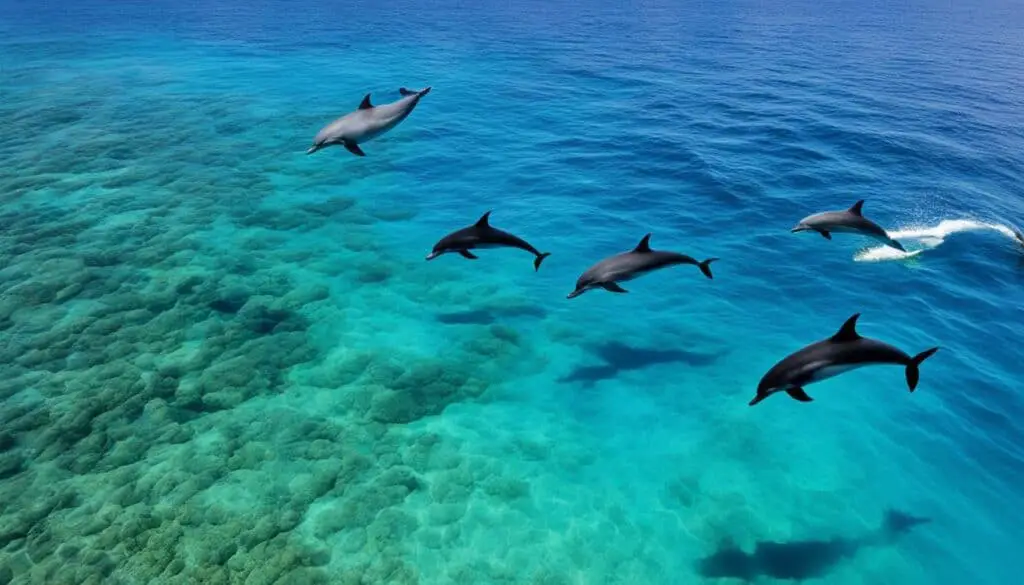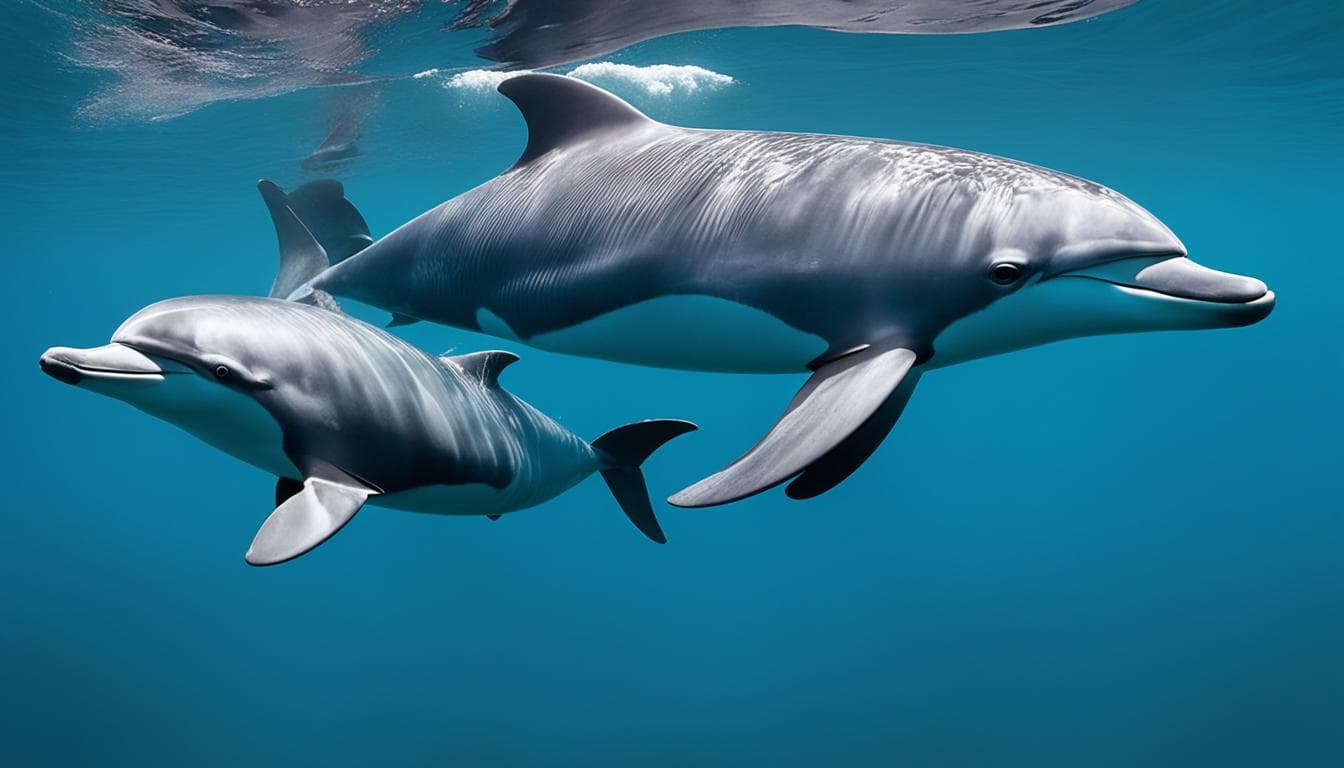Many people often wonder, how do porpoises differ from dolphins? They both belong to the cetacean family but have unique traits. Porpoises and dolphins are often mixed up, but they are really different. This section will show you the main differences between them. By learning about these differences, you’ll gain a deeper appreciation for marine life and the important roles these creatures have in our oceans.
Understanding the Cetacea Order
The Cetacea order includes a group of marine mammals crucial to the ocean’s balance. This group includes whales, dolphins, and porpoises. To understand cetaceans, we must look at their special traits and how they evolved.
What are Cetaceans?
Cetaceans have evolved to live in the water. They have streamlined bodies for swimming well. They have a dorsal fin and use echolocation to find their way and hunt in deep waters.
These features help them survive in the ocean. As we learn more about aquatic mammals, we see how these traits are key to their success.
The Evolution of Cetacea
Cetaceans evolved from land animals to marine mammals. They share a common ancestor with animals like hippos. Over time, they changed a lot to live in water.
These changes helped them adapt to life in both fresh and saltwater. Today, they can be found in oceans all over the world.
Classification of Dolphins and Porpoises
Dolphins and porpoises are in the cetacea order but are different families. Dolphins belong to Delphinidae and porpoises to Phocoenidae. They differ in size, shape, and how they live together.
Dolphins are bigger and longer than porpoises. Dolphins also live in groups, while porpoises are usually alone. These differences make each group interesting in its own way.
| Characteristic | Dolphins | Porpoises |
|---|---|---|
| Family | Delphinidae | Phocoenidae |
| Body Shape | Streamlined | Stocky |
| Dorsal Fin | Curved | Triangular |
| Social Structure | Highly social | More solitary |
| Size Range | 6.6 to 30 ft | 4.5 to 7 ft |
How do porpoises differ from dolphins?
Learning how to tell porpoises from dolphins can make you appreciate these sea creatures more. Both are in the Cetacea order but have clear physical and behavior differences.
Their body shapes are a big clue to their differences. Dolphins have long beaks and big, curved dorsal fins. Porpoises have round heads, smaller dorsal fins, and are more sturdy.
Looking at their teeth also shows their differences. Dolphins have cone-shaped teeth for their varied diet. Porpoises have spade-shaped teeth for catching different prey. This shows their different eating habits and how they adapt to their environments.
Dolphins love to be social and talk to each other. They live in big groups, play, and communicate well. Porpoises are shy and don’t socialize as much.
Physical Characteristics of Dolphins
Dolphins have many interesting physical features that help them in the water. Their anatomy shows how well they adapt to marine life.
Dolphin Body Structure
Dolphins are known for their sleek, muscular bodies. They range from 6 to 12 feet long. These features let them swim fast and make sharp turns underwater.
Their streamlined bodies make moving through the water efficient. This makes them some of the fastest marine mammals.
Dorsal Fin and Beak Differences
The dorsal fin’s shape and size are key in identifying different dolphins. Each fin is unique, helping to tell dolphins apart. Dolphins often have a distinct beak.
This beak helps them hunt and communicate. It shows how complex their bodies are.
Teeth Variation in Dolphins
Dolphins’ teeth are important for their survival. They have conical teeth for catching fish and squid. These teeth show how different dolphins eat and hunt.
Physical Characteristics of Porpoises
Porpoises have unique physical features that help them live in their environment. They are smaller than dolphins and have a special body shape. This section will look at their anatomy, body structure, and other key traits.
Porpoise Body Structure
Porpoises are smaller, ranging from 4 to 7 feet long. They have a sturdy body that’s perfect for cold waters near the coast. Their shape helps them swim well, letting them move through their home efficiently.
Distinctive Dorsal Fin Shape
Porpoises have a special dorsal fin. It’s not as long or curved as a dolphin’s fin. This fin is triangular and stands upright, helping them stay stable and move easily in the water. It’s a key part of their design.
Teeth Variation in Porpoises
Porpoises have unique teeth compared to dolphins. They have flat, spade-shaped teeth for catching fish and squid. This shows how they’ve adapted to eat certain foods over time.
| Feature | Porpoises | Dolphins |
|---|---|---|
| Average Length | 4 to 7 feet | 6 to 12 feet |
| Body Shape | Stocky | Streamlined |
| Dorsal Fin Shape | Triangular | Curved |
| Teeth Type | Spade-shaped | Conical |
Behavioral Differences between Dolphins and Porpoises
Exploring the behavioral differences between dolphins and porpoises reveals how unique their lives are. Dolphins and porpoises show different social behaviors, especially in how they live together and talk to each other.
Social Structures and Group Dynamics
Dolphins live in big, active groups called pods. These pods have complex social networks. They often change and have different pods interact with each other. Porpoises, on the other hand, usually stick together in small groups or go alone. This shows they prefer being alone more than dolphins do.
This difference comes from how dolphins and porpoises interact with each other. Dolphins are more social than porpoises, who like to be alone more often. Here’s a look at how they differ:
| Aspect | Dolphins | Porpoises |
|---|---|---|
| Pod Size | Large pods, sometimes over 20 individuals | Small groups, often 2-3 individuals |
| Social Interaction | Frequent interactions and social bonding | Limited interactions, more reserved |
| Complexity of Social Structure | High complexity with established hierarchies | Lower complexity, more straightforward relationships |
Communication Patterns
Dolphins and porpoises communicate in different ways. Dolphins use clicks, whistles, and body language to talk. They even play and use echolocation to talk to each other. Porpoises use softer sounds to communicate, which limits their social life.
This shows how their communication styles match their lives and where they live.
Habitat and Distribution
Learning about dolphins and porpoises’ habitats and where they live helps us understand them better. These marine animals have special preferences for their living spaces. This shapes their behaviors and how they adapt.
Geographic Range of Dolphins
Dolphins live in oceans all over the world, especially in warm and temperate areas. They can live in many types of water, from the coast to deep seas. This shows how they can change to fit their food needs and social life.
Geographic Range of Porpoises
Porpoises are pickier about where they live. They like cooler waters and stick to coastal areas, bays, and rivers. Sometimes, they live in the same places as dolphins but prefer cooler waters. Knowing this helps us see how they each play a role in their ecosystems.
| Feature | Dolphins | Porpoises |
|---|---|---|
| Habitat Distribution | Widespread in temperate and tropical oceans | Primarily in cooler coastal waters |
| Marine Environment Preferences | Coastal, estuarine, open sea | Coastal zones, bays, river estuaries |
| Adaptability | Highly adaptable to various environments | More selective with environmental preferences |

Similarities and Variances between Porpoises and Dolphins
Porpoises and dolphins are both part of the Cetacea order. They share many similarities between dolphins and porpoises. Both are smart and live in complex groups. They are interesting to watch and play a big role in the ocean.
They use echolocation to hunt and move around. This shows how common characteristics of cetaceans help them survive. Their smart hunting and social ways make them stand out.
Even though they look different, porpoise dolphin parallels show they share many traits. They work together in groups and face similar problems like losing their homes and dangers from fishing. This shows how connected they are in the ocean.
In the end, porpoises and dolphins are unique but also share many things. Their shared traits show how important they are for the ocean’s health. Understanding their differences and similarities helps us value marine life more. It also highlights the need to protect these amazing creatures.
FAQ
How do porpoises differ from dolphins?
Porpoises and dolphins are different in many ways. They have different body shapes and dorsal fins. Dolphins have long beaks and big, curved dorsal fins. Porpoises have round heads and smaller, triangular dorsal fins.
Porpoises also tend to be less social and don’t talk as much as dolphins.
What are the main physical distinctions between porpoises and dolphins?
Porpoises and dolphins differ in size and body shape. Dolphins are bigger, measuring 6 to 12 feet long. Porpoises are smaller, from 4 to 7 feet long.
Dolphins have a sleek body for speed, while porpoises are built for colder waters.
Are dolphins and porpoises social animals?
Yes, they are social but in different ways. Dolphins love to be in big groups and have complex social lives. Porpoises are usually alone or in small groups. They are more shy.
Where can I find dolphins and porpoises in the wild?
Dolphins live in warm and temperate oceans, near coasts and in the open sea. Porpoises prefer shallower waters near the shore and like colder areas.
What similarities do dolphins and porpoises share?
Dolphins and porpoises are both smart and have complex behaviors. They use echolocation to find their way and hunt. They also face threats like losing their homes and getting caught in fishing nets.
How do the teeth of porpoises and dolphins differ?
Porpoises have spade-shaped teeth, while dolphins have cone-shaped teeth. These teeth help them eat different foods and hunt in different ways.
What is the significance of understanding the differences between porpoises and dolphins?
Knowing how porpoises and dolphins are different helps us appreciate marine life more. It also helps us protect these smart creatures.







